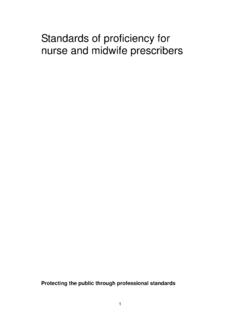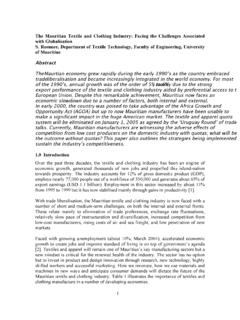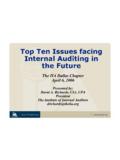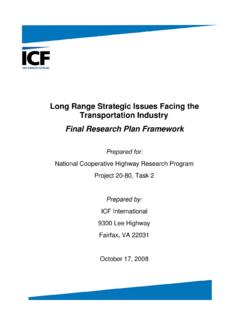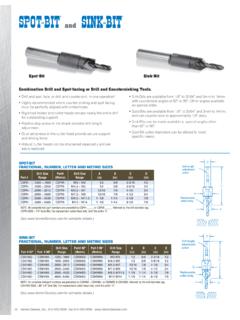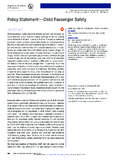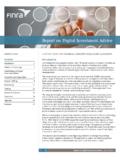Transcription of Facing the future - e-health nurses
1 Facing the futureA review of the roleof health visitorsChair: Rosalynde Lowe 2A review of the role of health visitorsChair: Rosalynde Lowe, Queen s Nursing InstitutePublished June 2007 Crown Copyright 2007 The text of this document may bereproduced without formal permission orcharge for personal or in-house at the future 3 ContentsForeword4 Executive visiting 1: Core elements of health visiting17 Recommendation 2: Focus18 Recommendation 3: Priorities19 Recommendation 4: Commissioning21 Recommendation 5: Level of practice22 Recommendation 6: The primary role of the health visitor23 Recommendation 7: Additional areas of practice27 Recommendation 8: Organisational options28 Getting from here to there29 Recommendation 9: National A: Health Visitor Review Working Group: Terms of reference33 Annex B: Membership of the Health Visitor Review Working Group34 4 Many years ago, health visiting was my chosen profession and it hasalways remained very close to my heart.
2 I was therefore delighted andhonoured to be asked to chair this some time now, there have been concerns that health visiting hadlost its focus, or rather, there seemed to be too many foci for anyone,even health visitors themselves, to be able to define what healthvisiting was about and what health visitors should be doing. This ismore than a pity; it has meant that the important, and often unseen,work that health visitors are doing has gone unrecognised andtherefore say we now live in a rapidly changing world is a truism, butcertainly the changes in the way we expect to use technology,communication and health services have been massive. Put alongsidethe equally massive changes in the way health services are organised,it is perhaps unsurprising that the health visiting profession and thosecharged with commissioning their services and education have, inmany areas, appeared to have lost their review into the future role of health visitors will give the healthvisiting profession and the health service as a whole, a realopportunity to sharpen, clarify and revitalise the health visitor s role.
3 Itis not about more health visitors doing the same job they have alwaysdone but rather focussing their skills and expertise on where they canmake the greatest impact: in early intervention with children andfamilies, and in tackling the difficult issues in vulnerable families andcommunities within a public health visitors have never worked in isolation, and the wide range ofpeople contributing to this review reflects that broad reach. I wouldlike to thank everyone who sent in comments and references,attended workshops, held discussions with their colleagues over coffeeor the internet, or who worked so hard in the review group. While Ihave tried to cite as much supporting evidence as possible, it isbeyond the scope of this report to produce a comprehensive literaturereview of all relevant ever proof were needed that health visiting is a valued professionand health visitors valued colleagues, then the response we have hadin undertaking this review is definitely proof positive. It is now up toall of us to put it to good LoweChair, Health Visitor Review GroupForeword The review was asked to describe a renewed role for health visitorsthat: Delivers measurable health outcomes for individuals andcommunities and provides a rewarding and enjoyable job fornurses Has the support of families and communities PCTs and practice based commissioners will commission Delivers government policies for children and families, improvinghealth and reducing inequalities and social exclusion Fits the new system of providing choice and contestabilitythrough new providers, that promotes self-care, serviceintegration, improved productivity and local decision making Can adapt and respond to changing needs and aspirations Attracts a new generation to the profession.
4 In so doing, the need has been identified to reform the existinghealth visiting service into a fully integrated preventive service forchildren and families within a public health context. Two primary roles have been identified for which the skills andknowledge of the health visitor are an essential requirement. Thiswill provide the opportunity to improve the health and wellbeing ofchildren, families and communities, and address some of the keypublic health issues Facing society today. The review has identified that the range and complexity of childrenand families today means that it is not simply a question of havingmore health visitors doing the same work. The formation of welltrained and competent teams led by a health visitor will ensure thata universal preventive health service can be effectively andefficiently delivered to all families with young children. The final recommendation on national policy is key to ensuring thesupport and successful implementation of this summary5 Executive summary6 RECOMMENDATION 1: The core elements of healthvisiting should be: Public health and nursing Working with the whole family Early intervention and prevention The value of knowing the community and being local Pro-active in promoting health and preventing ill health Progressive universalism Safeguarding children The value of working across organisational boundaries Team work and partnership Readiness to provide health protection service Home 2: Focus The focus of health visitors should be early intervention, preventionand health promotion for young children and families as this is wheretheir nursing and public health skills and knowledge can have thegreatest 3: PrioritiesPriorities in which health visitors will need to play a lead role are.
5 Preventing social exclusion in children and families Reducing inequalities Tackling the key public health priorities in particular, obesity,smoking, alcohol, drugs and accident prevention Promoting infant, child and family mental health Supporting the capacity for better parenting improvingpregnancy outcomes, child health and development, parents economic self-sufficiency, safeguarding children, addressingdomestic violence, supporting parental relationships and fathers intheir parenting role. Executive summary7 RECOMMENDATION 4: CommissioningCommissioners should commission early intervention, preventive andhealth promotion services for all young children and 5: Level of practiceHealth visitors are public health nurses working with young childrenand families. As highly trained professionals they should beresponsible for the difficult things : Managing risk/decision making in conditions of uncertainty,including safeguarding children Building therapeutic relationships and addressing difficult issues infamilies with complex needs Leading multi-skilled teams Working across sectors and putting health into multi-agency work Delivering population level outcomes Assessment and identification of existing and future vulnerability Engaging hard to reach groups and individuals Translating evidence into 6: The primary role of the healthvisitor should be either: Leading and delivering the Child Health Promotion Programmeusing a family focused public health approach, or Delivering intensive programmes for the most vulnerable childrenand 7: Additional areas of practiceThere are two further packages of services that health visitors or othernurses can provide depending on local circumstances.
6 Wider public health packages Primary care nursing service for children and families. Executive summary8 RECOMMENDATION 8: Organisational optionsHealth visitors are a key part of an integrated children s service;whether they are located within children s centres or the primaryhealth care team, should be determined locally. RECOMMENDATION 9: National policyNational policy should support the implementation of this review by:1. Issuing national guidance that strengthens and updates the NSFstandard on the Child Health Promotion Programme and goesbeyond the minimum core to include a model of progressiveuniversalism bringing together screening, early detection, healthpromotion, health protection and parenting support into oneprogramme for all families2. Assembling the relevant research findings to support a 21st centurychild and family health promotion service3. Strengthening the commissioning of early intervention andprevention health services for children4. Leading the development of the workforce through ModernisingNursing Careersto support current and future health visitors toundertake the roles described in this review 5.
7 Clarifying and promoting the contribution of health in thegovernment s policy on parenting. 9 Health visiting has a long and proud tradition in this country. We arefortunate to have a profession founded on universalism andprevention that combines nursing and public health and has legitimacywith the public. For many generations health visitors have been avalued resource and have had a positive influence on the health andwellbeing of families and young children. Yet throughout this reviewwe have been faced with the question of why the profession seemslost and under pressure when the very issues where health visitors canmake a positive difference have never had greater prominence in thepublic s mind and government policy. We have found that the answerto this paradox lies in many quarters and the solutions aremultifaceted. This report illustrates this by drawing on the views ofmany people, providing an analysis of health visiting today and settingout a vision for the future . An overwhelming message has been theneed for clarity and direction about the current and future role ofhealth visitors for commissioners, health visitors, other professions,leaders and the public.
8 Introduction1 Modernising Nursing Careers Modernising Nursing Careers(MNC) published by the Department ofHealth in 2006 outlines how nursing roles and responsibilities will changeand sets the direction for modern nursing careers. MNC identified fourpriority areas that need to be addressed to ensure that nursing is fit for thefuture. As part of the family of nursing these apply to health visitors andhave shaped this review. Develop a competent and flexible workforce Update career pathways and career choices Prepare nurses to lead in a changed health system Modernise the image of nursing and nursing careersThis review has been undertaken as part of Modernising NursingCareers(MNC) which was published in 2006 and sets the futuredirection for the careers and educational preparation of all in keeping with devolved responsibility and local decision 10 Purpose of the reviewTo describe the future role of the healthvisitor and make recommendations fordeveloping and implementing the role in thecontext of Modernising Nursing , this report does not tell the service what to do, neither does itmake recommendations on numbers and resources.
9 Rather, itdescribes a role for the future that focuses on the needs of childrenand families and on what commissioners, providers and the healthvisiting profession need to do to implement that role. This review isinformed by evidence, government policy and the views of manystakeholders. Its implementation will depend on strengthening thecommissioning of preventive services for children, modernising nursingcareers and change by the health visiting profession itself. Importantlywe aim to support those leaders and practitioners on the ground whoare forging ahead and developing a profession that will have aconfident, relevant and sustainable future for the benefit of thenation s health and wellbeing. 11 The changing context for health visitorsHealth visitors, like everyone else in the public sector, work in a worldof perpetual change. Society is changing. There is greater social,cultural, racial and geographical diversity in the UK today. Thepopulation, including the workforce, is ageing, long term conditionsare increasing, inequalities are proving hard to shift and developmentsin science and technology aim to change what is possible and howservices are delivered.
10 Government reforms aim to change the wayservices are provided, putting patients, users and the public first,providing more care closer to home and enabling more choice forindividuals. The emphasis is on service integration, prevention andhealth promotion along with self-care and improving care for peoplewith long term conditions. Health visitors arguably face a wider range of changes and influencesthan other groups of nurses . This is because of their holistic view ofhealth and prevention and their position at the interface between theNHS and local authority, nursing and public health, general practiceand children s centres. Factors impacting on health visiting include: Cross government policieson public health, children and socialexclusion Emerging knowledge and evidence on the neurologicaldevelopment of young children, mental health promotion, theeffectiveness of early intervention and prevention, parentingprogrammes and home visiting A greater emphasis on evidence-based programmeswithmeasurable outcomes Progressive universalisma universal service that is systematicallyplanned and delivered to give a continuum of support according toneed at neighbourhood and individual level in order to achievegreater equity of outcomes for all childrenHealthvisiting today2 12 Current and future global health threats and health problemsfacing the modern world.

